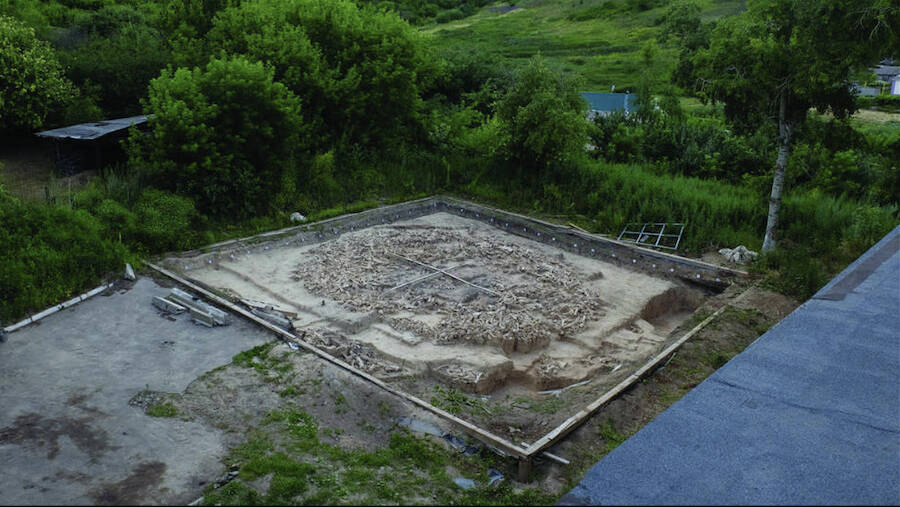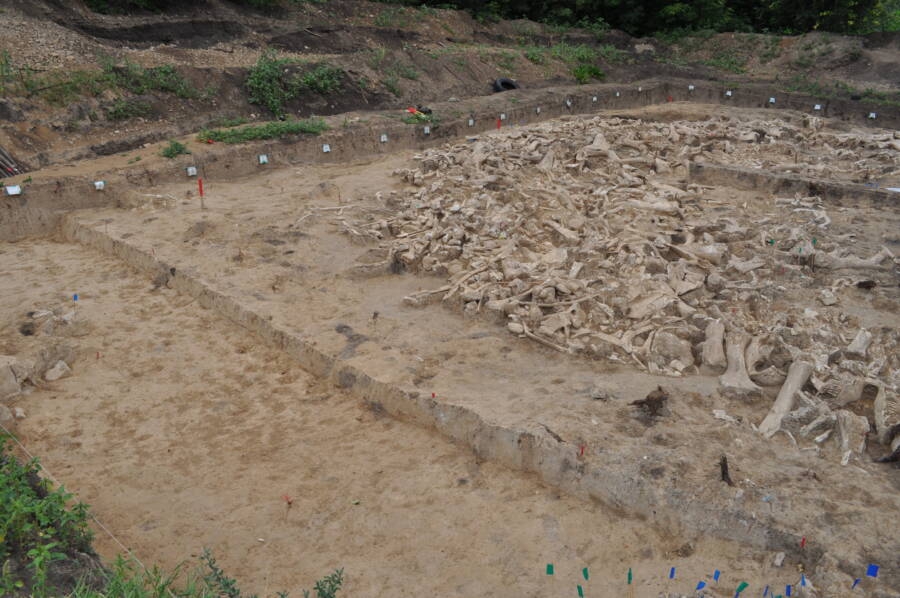"Archaeology is showing us more about how our ancestors survived in this desperately cold and hostile environment at the climax of the last ice age."

A. J. E. Pryor et al., 2020/AntiquityThe structure measured 30 feet by 30 feet and was made of 51 mammoth jawbones and 64 mammoth skulls.
Researchers in Russia have excavated an extraordinary hunter-gatherer relic that is baffling experts. The large structure they found is not only 25,000 years old, but it’s also made from the bones of more than 60 mammoths. Nobody quite knows why.
According to CNN, researchers discovered comparable but smaller buildings at this same site in the 1960s and 1970s. The excavation site has since been dubbed Kostenki 11, and it sits 310 miles south of Moscow. This latest find is now officially the oldest and largest “mammoth house” ever found there.
While researchers found evidence of this structure as early as 2014, they only began excavating the following year — and didn’t stop until 2018. Published in the Antiquity journal, their findings detail a structure that measures about 30 feet by 30 feet and is composed of mammoth bones that date back to the Ice Age.
The University of Exeter team was led by paleontological archaeologist Dr. Alexander Pryor. According to Phys, the discovery of this prehistoric structure and its contents may force us to reassess what we know about this period.
“Archaeology is showing us more about how our ancestors survived in this desperately cold and hostile environment at the climax of the last ice age,” Pryor said. “Most other places at similar latitudes in Europe had been abandoned by this time, but these groups had managed to adapt to find food, shelter and water.”

A. J. E. Pryor et al., 2020/AntiquityThe bones of reindeer, horses, bears, wolves, red foxes, and arctic foxes were also found at the site.
In a welcome surprise, the excavation team also discovered the remains of charred wood, which suggests that humans burned wood fires in the mammoth structure.
Experts also found remains of plants nearby, which hints at plants being a component of these hunter-gatherers’ diets. Of course, their plant use likely also included the creation of medicines, fabric, and string.
The walls of this structure were built from 51 mammoth jawbones and 64 mammoth skulls. While they once stood tall, they’re now strewn about the interior, alongside bones of other animals like reindeer, foxes, and horses.
Researchers posit that the remains were sourced from local animal graveyards, and that the structure was simply hidden by a buildup of sediment over the years. As it stands, the structure is now about one foot below the surface level. As for why these early humans chose this particular spot to build the structure, Pryor has a guess.

A. J. E. Pryor et al., 2020/AntiquityA University of Exeter team member digs through the colossal pile of mammoth bones.
“Kostenki 11 represents a rare example of Palaeolithic hunter-gatherers living on in this harsh environment,” Pryor said. “What might have brought ancient hunter gatherers to this site? One possibility is that the mammoths and humans could have come to the area on masse because it had a natural spring that would have provided unfrozen liquid water throughout the winter — rare in this period of extreme cold.”
The last ice age, which hit northern Europe between 18,000 and 75,000 years ago, was at its coldest and most severe when Kostenki 11 was built. Temperatures commonly dipped well below zero. This caused most communities to leave the region — but not this one for some reason.
Ultimately, researchers believe that this structure was a place of some kind of cultural significance.
“It clearly meant something to them, and there was very likely a ritual element to it, even if the structure ultimately had some sort of practical purpose too,” said Pryor.

A. J. E. Pryor et al., 2020/AntiquityIt remains unclear what the purpose of this structure was, though food storage is one working theory.
It remains a mystery just how the mammoth bones were collected.
“It’s not yet clear whether the bones are from mammoths recently hunted and killed by humans or if they were scavenged from carcasses of animals that died of natural causes,” Pryor said.
Some believe the mammoth house was used exclusively for food storage, which makes sense regarding the lethal scarcity that an ice age of its kind wreaks upon the planet. As it stands, Pryor thinks Kostenki 11 is simply too large to have been an actual home.
Researchers are currently investigating further and analyzing their findings. But one thing is clear: Our insight into prehistoric structures made of mammoth bones just got a lot more interesting.
After learning about this 25,000-year-old structure built from mammoth bones, read about a scientific plan to resurrect the woolly mammoth. Then, learn about archaeologists uncovering 3,000-year-old Scottish weapons underneath a soccer field.





